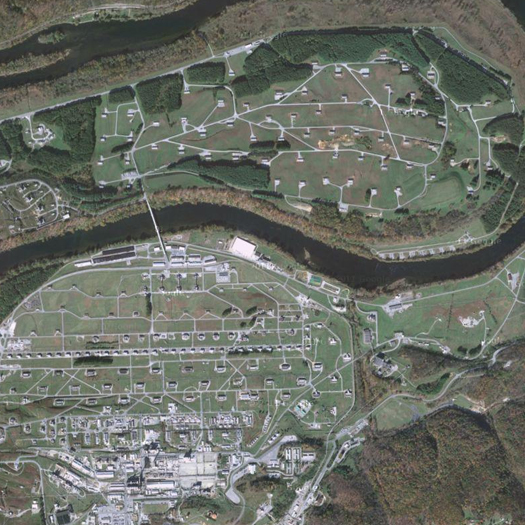
[The Radford Army Ammunitions Plant on the New River, in southwest Virginia.]
FASLANYC takes us on a tour of particularly bizarre militarized landscape typology — the World War II-era munitions plant, beginning with the Radford Army Ammunitions Plant in southwestern Virgina. Digging into the archives at the Historic American Landscapes Survey, Davis excavates the fascinating generative logic governing the spatial patterns of these sites:
Buildings used in the first stage of the process, where the material handled is highly flammable but not explosive, are grouped together in a section known as the “cotton area.” Those used in the second stage, where the material handled is highly explosive, are widely spaced and form what is called the “powder line.” Material is conveyed from one building to another first by flumes, then by motor trucks, and finally- when the highly explosive stage is reached- by small hand carts.
… From here on a unique type of construction, adapted to handling explosive materials, is required. All of the buildings in the powder line make use of “blow out” construction designed to control the direction of an explosion through one or more extremely light screens which will “blow-out” with a minimum increase in the air pressure within the building.
A second method of limiting the effects of explosions… is used in the solvent recovery buildings and those in the finishing area, which are spaced from all other buildings and from each other and surrounded by barricades. Spacing varies according to the maximum amount of explosive which is to be processed or stored in the building at any one time.
Barricades are constructed of heavy timbers with a plank face on each side and a screened dirt fill, making a solid wall with an average of approximately 5-foot thickness to absorb the shock of any possible explosion. Their height roughly corresponds to the height of the buildings they surround.
Read more at FASLANYC. As he suggests, this adds an important twist to the study of militarized landscapes — expanding beyond demilitarized zones, cities under permanent siege, and military abandonia to include the industrial landscapes that literally fuel the production of those other places.

